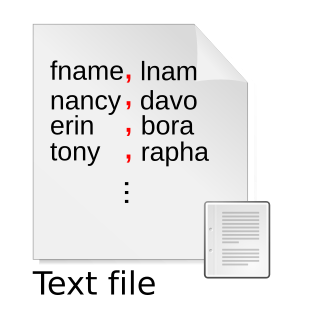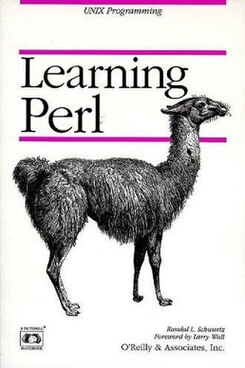
Perl is a family of two high-level, general-purpose, interpreted, dynamic programming languages. "Perl" usually refers to Perl 5, but it may also refer to its redesigned "sister language", Perl 6.

A regular expression, regex or regexp is a sequence of characters that define a search pattern. Usually this pattern is used by string searching algorithms for "find" or "find and replace" operations on strings, or for input validation. It is a technique developed in theoretical computer science and formal language theory.

Randal L. Schwartz, also known as merlyn, is an American author, system administrator and programming consultant.
Parrot is a register-based process virtual machine designed to run dynamic languages efficiently. It is possible to compile Parrot assembly language and PIR to Parrot bytecode and execute it. Parrot is free and open source software.
In computer science, constraint programming is a programming paradigm wherein relations between variables are stated in the form of constraints. Constraints differ from the common primitives of imperative programming languages in that they do not specify a step or sequence of steps to execute, but rather the properties of a solution to be found. This makes constraint programming a form of declarative programming. The constraints used in constraint programming are of various kinds: those used in constraint satisfaction problems, linear inequalities, and others. Constraints are usually embedded within a programming language or provided via separate software libraries.

Programming Perl, best known as the Camel Book among programmers, is a book about writing programs using the Perl programming language, revised as several editions (1991-2012) to reflect major language changes since Perl version 4. Editions have been co-written by the creator of Perl, Larry Wall, along with Randal L. Schwartz, then Tom Christiansen and then Jon Orwant. Published by O'Reilly Media, the book is considered the canonical reference work for Perl programmers. With over 1,000 pages, the various editions contain complete descriptions of each Perl language version and its interpreter. Examples range from trivial code snippets to the highly complex expressions for which Perl is widely known. The camel book editions are also noted for being written in an approachable and humorous style.

A delimiter is a sequence of one or more characters used to specify the boundary between separate, independent regions in plain text or other data streams. An example of a delimiter is the comma character, which acts as a field delimiter in a sequence of comma-separated values. Another example of a delimiter is the time gap used to separate letters and words in the transmission of Morse code.
Plain Old Documentation (pod) is a lightweight markup language used to document the Perl programming language.

Intermediate Perl is a book about the Perl programming language by Randal L. Schwartz, brian d foy and Tom Phoenix, published in 2006 by O'Reilly Media. It was released as a retitled second edition of Learning Perl Objects, References & Modules (ISBN 0-596-00478-8) by Schwartz and Phoenix, published by O'Reilly Media in 2003 to favorable reviews. A second edition of Intermediate Perl was released in 2012.
In computer programming, the Schwartzian transform is a technique used to improve the efficiency of sorting a list of items. This idiom is appropriate for comparison-based sorting when the ordering is actually based on the ordering of a certain property of the elements, where computing that property is an intensive operation that should be performed a minimal number of times. The Schwartzian transform is notable in that it does not use named temporary arrays.

Blosxom is a free-software weblog program written in Perl by Rael Dornfest. It uses the pre-existing file system instead of a database management system, unlike most blog software.

LAMP is an archetypal model of web service stacks, named as an acronym of the names of its original four open-source components: the Linux operating system, the Apache HTTP Server, the MySQL relational database management system (RDBMS), and the PHP programming language. The LAMP components are largely interchangeable and not limited to the original selection. As a solution stack, LAMP is suitable for building dynamic web sites and web applications.

Jonathan Gillette, known by the pseudonym why the lucky stiff, is a writer, cartoonist, artist, and programmer notable for his work with the Ruby programming language. Annie Lowrey described him as "one of the most unusual, and beloved, computer programmers" in the world. Along with Yukihiro Matsumoto and David Heinemeier Hansson, he was seen as one of the key figures in the Ruby community.

brian d foy [sic] is the former publisher and editor of The Perl Review, a magazine devoted to Perl and co-author of several books on Perl including Learning Perl, Intermediate Perl and Mastering Perl. He is also the founder of Perl Mongers, the founder of the White Camel Awards, a frequent speaker at conferences including The Perl Conference and YAPC. He is the author of multiple Perl modules on CPAN and maintains the perlfaq portions of the core Perl documentation. He was a partner at Stonehenge Consulting Services from 1998 to 2009.

Alex Martelli is an Italian computer engineer and Fellow of the Python Software Foundation. Since early 2005, he works for Google, Inc. in Mountain View, California, for the first few years as "Über Tech Lead," then as "Senior Staff Engineer," currently in charge of "long tail" community support for Google Cloud Platform.

chromatic is a writer and free software programmer best known for his work in the Perl programming language. He lives in Hillsboro, Oregon, United States. He wrote Extreme Programming Pocket Guide, co-wrote of Perl Testing: A Developer's Notebook, is lead author of Perl Hacks, and an uncredited contributor to The Art of Agile Development. He has a music degree. He has contributed to CPAN, Perl 5, Perl 6, and Parrot.
CoffeeScript is a programming language that transcompiles to JavaScript. It adds syntactic sugar inspired by Ruby, Python and Haskell in an effort to enhance JavaScript's brevity and readability. Specific additional features include list comprehension and pattern matching.
PerlTidy is a tool written in the Perl programming language to do static code analysis against code written in that same language. It uses either command-line switches or configuration files to reformat Perl scripts so they comply with specified coding rules. The default configuration is an approximation of the Perl Style Guide.














